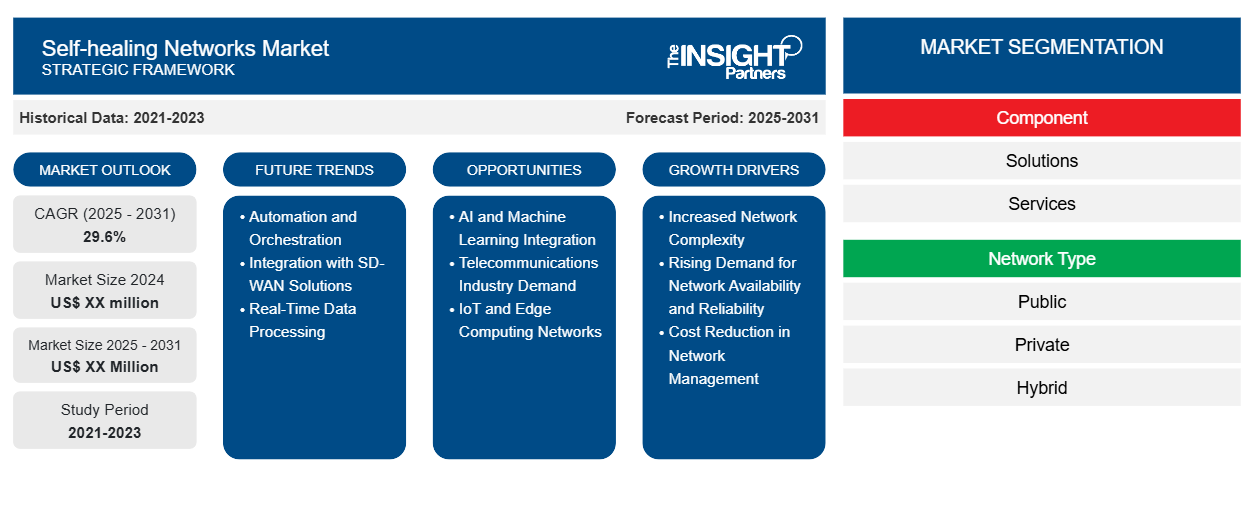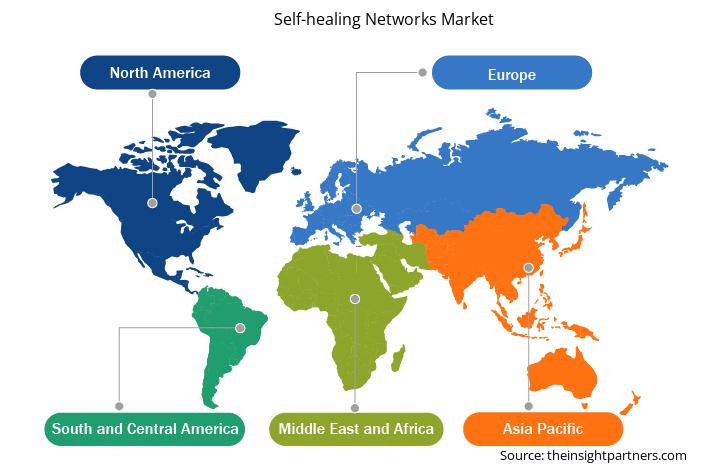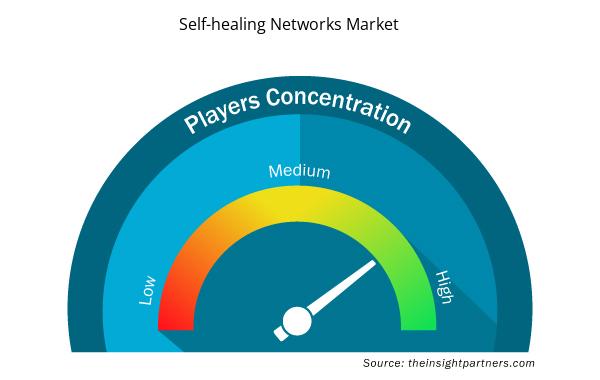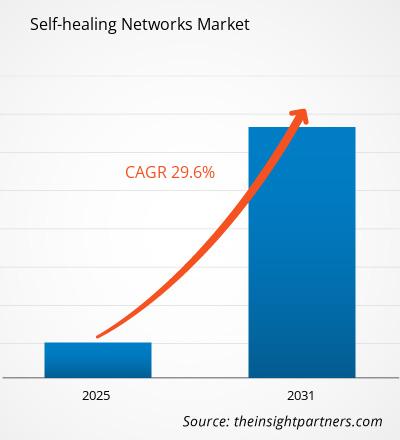The Self-healing Networks Market is expected to register a CAGR of 29.6% from 2025 to 2031, with a market size expanding from US$ XX million in 2024 to US$ XX Million by 2031.
The report is segmented by Component (Solutions, Services), Network Type (Public, Private, Hybrid), Application (Network Provisioning, Network Traffic Management,, Network Bandwidth Monitoring, Policy Management, Security Compliance Management, Root Cause Analysis, Network Access Control, Other), Vertical (IT and ITES, BFSI, Media and Entertainment, Healthcare and Life Sciences, Telecom, Retail and Consumer Goods, Education, Other). The global analysis is further broken-down at regional level and major countries. The report offers the value in USD for the above analysis and segments
Purpose of the Report
The report Self-healing Networks Market by The Insight Partners aims to describe the present landscape and future growth, top driving factors, challenges, and opportunities. This will provide insights to various business stakeholders, such as:
- Technology Providers/Manufacturers: To understand the evolving market dynamics and know the potential growth opportunities, enabling them to make informed strategic decisions.
- Investors: To conduct a comprehensive trend analysis regarding the market growth rate, market financial projections, and opportunities that exist across the value chain.
- Regulatory bodies: To regulate policies and police activities in the market with the aim of minimizing abuse, preserving investor trust and confidence, and upholding the integrity and stability of the market.
Self-healing Networks Market Segmentation
Component
- Solutions
- Services
Network Type
- Public
- Private
- Hybrid
Application
- Network Provisioning
- Network Traffic Management
- Network Bandwidth Monitoring
- Policy Management
- Security Compliance Management
- Root Cause Analysis
- Network Access Control
- Other
Vertical
- IT and ITES
- BFSI
- Media and Entertainment
- Healthcare and Life Sciences
- Telecom
- Retail and Consumer Goods
- Education
- Other
Customize This Report To Suit Your Requirement
You will get customization on any report - free of charge - including parts of this report, or country-level analysis, Excel Data pack, as well as avail great offers and discounts for start-ups & universities
Self-healing Networks Market: Strategic Insights

- Get Top Key Market Trends of this report.This FREE sample will include data analysis, ranging from market trends to estimates and forecasts.
Self-healing Networks Market Growth Drivers
- Increased Network Complexity: With the growth of Internet of Things (IoT) devices, 5G networks, and cloud-based applications, network infrastructures are becoming more complex and difficult to manage. Self-healing networks automatically detect, diagnose, and resolve issues, helping to maintain optimal performance without the need for manual intervention, thus driving the demand for such solutions.
- Rising Demand for Network Availability and Reliability: Businesses and consumers increasingly rely on uninterrupted network service. Downtime can lead to significant losses in productivity and revenue. Self-healing networks ensure continuous uptime by automatically fixing failures or rerouting traffic in case of network issues, making them crucial for businesses that require constant and reliable connectivity.
- Cost Reduction in Network Management: Traditional network maintenance requires significant manual intervention, leading to high operational costs. Self-healing networks reduce the need for human resources and improve overall efficiency by automating troubleshooting, maintenance, and repairs. This results in lower operational costs, driving more businesses to adopt self-healing network solutions.
Self-healing Networks Market Future Trends
- Automation and Orchestration: The trend toward network automation is accelerating, with self-healing networks being a key component. Automation and orchestration tools enable networks to independently manage and resolve issues such as traffic congestion or hardware failure, reducing the need for manual intervention and allowing for faster recovery, improving network performance.
- Integration with SD-WAN Solutions: Software-Defined Wide Area Networks (SD-WAN) are becoming increasingly integrated with self-healing technologies. This integration allows businesses to optimize and automate their wide-area network operations, ensuring better resilience and fault tolerance across distributed networks. The combination enhances network agility and reliability, making it easier for businesses to manage large-scale networks.
- Real-Time Data Processing: Self-healing networks are moving towards real-time data processing, where issues are detected and addressed immediately as they arise. This trend ensures that networks can recover from disruptions without delay, preventing performance degradation. Real-time analytics helps in making instant adjustments to optimize the network, minimizing downtime and improving user experience.
Self-healing Networks Market Opportunities
- AI and Machine Learning Integration: AI and machine learning can be integrated into self-healing networks to improve their predictive capabilities. By analyzing vast amounts of network data, AI can help identify potential issues before they occur, enabling preemptive actions and enhancing the system’s ability to self-repair, opening up new opportunities in automation and intelligent network management.
- Telecommunications Industry Demand: The telecom industry is increasingly investing in self-healing network technologies to enhance the reliability and efficiency of their infrastructures. With the rapid expansion of 5G networks, there’s a growing opportunity for self-healing solutions to ensure these complex networks remain functional, especially as they scale to handle higher data volumes and diverse applications.
- IoT and Edge Computing Networks: As IoT devices and edge computing become more prevalent, the number of connected devices and networks increases, leading to higher risks of network disruptions. Self-healing networks can manage and secure IoT systems, ensuring smooth operations in environments where traditional network management models might struggle, thus opening new opportunities in IoT security and reliability.
Self-healing Networks Market Regional Insights
The regional trends and factors influencing the Self-healing Networks Market throughout the forecast period have been thoroughly explained by the analysts at Insight Partners. This section also discusses Self-healing Networks Market segments and geography across North America, Europe, Asia Pacific, Middle East and Africa, and South and Central America.

- Get the Regional Specific Data for Self-healing Networks Market
Self-healing Networks Market Report Scope
| Report Attribute | Details |
|---|---|
| Market size in 2024 | US$ XX million |
| Market Size by 2031 | US$ XX Million |
| Global CAGR (2025 - 2031) | 29.6% |
| Historical Data | 2021-2023 |
| Forecast period | 2025-2031 |
| Segments Covered |
By Component
|
| Regions and Countries Covered | North America
|
| Market leaders and key company profiles |
Self-healing Networks Market Players Density: Understanding Its Impact on Business Dynamics
The Self-healing Networks Market market is growing rapidly, driven by increasing end-user demand due to factors such as evolving consumer preferences, technological advancements, and greater awareness of the product's benefits. As demand rises, businesses are expanding their offerings, innovating to meet consumer needs, and capitalizing on emerging trends, which further fuels market growth.
Market players density refers to the distribution of firms or companies operating within a particular market or industry. It indicates how many competitors (market players) are present in a given market space relative to its size or total market value.
Major Companies operating in the Self-healing Networks Market are:
- Fortra
- VMWare
- IBM
- CommScope
- SolarWinds
- ManageEngine
Disclaimer: The companies listed above are not ranked in any particular order.

- Get the Self-healing Networks Market top key players overview
Key Selling Points
- Comprehensive Coverage: The report comprehensively covers the analysis of products, services, types, and end users of the Self-healing Networks Market, providing a holistic landscape.
- Expert Analysis: The report is compiled based on the in-depth understanding of industry experts and analysts.
- Up-to-date Information: The report assures business relevance due to its coverage of recent information and data trends.
- Customization Options: This report can be customized to cater to specific client requirements and suit the business strategies aptly.
The research report on the Self-healing Networks Market can, therefore, help spearhead the trail of decoding and understanding the industry scenario and growth prospects. Although there can be a few valid concerns, the overall benefits of this report tend to outweigh the disadvantages.
- Historical Analysis (2 Years), Base Year, Forecast (7 Years) with CAGR
- PEST and SWOT Analysis
- Market Size Value / Volume - Global, Regional, Country
- Industry and Competitive Landscape
- Excel Dataset


- Lyophilization Services for Biopharmaceuticals Market
- Intraoperative Neuromonitoring Market
- Bio-Based Ethylene Market
- Enteral Nutrition Market
- Passport Reader Market
- Fill Finish Manufacturing Market
- Digital Pathology Market
- Automotive Fabric Market
- Equipment Rental Software Market
- Sterilization Services Market

Report Coverage
Revenue forecast, Company Analysis, Industry landscape, Growth factors, and Trends

Segment Covered
This text is related
to segments covered.

Regional Scope
North America, Europe, Asia Pacific, Middle East & Africa, South & Central America

Country Scope
This text is related
to country scope.
Frequently Asked Questions
Some of the customization options available based on the request are an additional 3–5 company profiles and country-specific analysis of 3–5 countries of your choice. Customizations are to be requested/discussed before making final order confirmation# as our team would review the same and check the feasibility
The report can be delivered in PDF/PPT format; we can also share excel dataset based on the request
Automation and Orchestration, Integration with SD-WAN Solutions
Increased Network Complexity, Rising Demand for Network Availability and Reliability, Cost Reduction in Network Management
The global Self-healing Networks market is expected to grow at a CAGR of 29.6% during the forecast period 2024 - 2031

 Get Free Sample For
Get Free Sample For